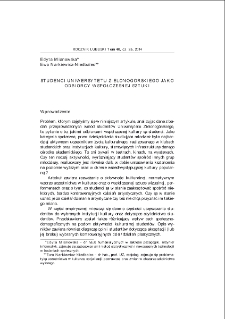Digital Library of Zielona Góra contains 9 272 digital objects
Object
Title: Studenci Uniwersytetu Zielonogórskiego jako odbiorcy współczesnej sztuki = University of Zielona Gora students as the receivers of contemporary art
Contributor:
Group publication title:
Abstract_pl:
Autorki przede wszystkim poszukują odpowiedzi na pytania o to: (1) jakimi odbiorcami współczesnej kultury i sztuki są studenci, (2) czy utrzymali oni status kategorii kulturotwórczej i głównych odbiorców kultury, (3) czy ten rodzaj aktywności, wyróżniający studentów spośród innych grup młodzieży realizowany jest również dziś, w dobie umasowienia kształcenia na poziomie wyższym oraz w okresie wszechwystępującej kultury popularnej. ; Artykuł w warstwie teoretycznej zawiera rozważania dotyczące kultury współczesnej, dotyczące między innymi tego, jak wśród ofert kultury popularnej odszukać te najbardziej wartościowe treści, kto instytucjonalnie jest opiniotwórczy w sferze kultury i czy wśród studentów małego ośrodka akademickiego odczuwany jest normatywny wzorzec uczestnictwa w kulturze. W warstwie empirycznej artykuł zawiera dane o częstotliwości uczęszczania studentów do wybranych instytucji kultury.
Abstract:
The paper presents the results of empirical research conducted at the beginning of 2011 concerning the participation of University of Zielona Gora students in culture. One group of the examined students was randomly chosen, the other was selected deliberately among the students of pedagogy, and the third group included the students of the Faculty of Arts - musicians and visual artists who agreed to participate in the research. ; The following indicators of participation in culture were adopted: going to the cinema, theatre, concert hall, pop music concerts (rock) and reading books. Students most often go to the cinema and relatively often to pop music concerts. They definitely rarely go to the theatre and only occasionally to the concert hall. It was checked what characteristics (sex, financial situation, being in a relationship, education of parents) differentiate participation in culture. A significant difference applies to reading - female students (80%) more often read books than male students (68%). ; Another exception presented in the article is the way of perceiving contemporary and controversial pieces of art or artistic activities. Students are divided into almost three equal groups: those who recognize the artistic freedom, those who recognize certain works/activities as a manifestation of art. but cannot accept them personally, and those who refuse the name of art to controversial pieces of art/activities.
Publisher:
Zielona Góra: Lubuskie Towarzystwo Naukowe
Format:
Resource Identifier:
Pages:
Source:
Rocznik Lubuski, tom 40, część 2a
Language:
Rights:
Biblioteka Uniwersytetu Zielonogórskiego
Object collections:
- Repository > Faculties > Faculty of Education, Psychology and Sociology
- Repository > Types of work > Articles
- Repository > Scientific journals and UZ publishing series > Lubuski Yearbook
Last modified:
Jul 25, 2024
In our library since:
Jul 25, 2024
Number of object content hits:
121
All available object's versions:
https://zbc.uz.zgora.pl/repozytorium/publication/90016
Show description in RDF format:
Show description in OAI-PMH format:
Objects Similar
Narkiewicz-Niedbalec, Ewa Dzieńdziura, Krzysztof Narkiewicz-Niedbalec, Ewa - red. Hajduk, Edward (1932-2015) - red.
Narkiewicz-Niedbalec, Ewa Bazuń, Dorota - red. Kwiatkowski, Mariusz - red.
Mianowska, Edyta Narkiewicz-Niedbalec, Ewa - red. Hajduk, Edward (1932-2015) - red.
Narkiewicz-Niedbalec, Ewa Mianowska, Edyta Szaban, Dorota - red. Trzop, Beata - red.
Narkiewicz-Niedbalec, Ewa Mianowska, Edyta Idzikowski, Bogdan - red. Kowalski, Mirosław - red.
Narkiewicz-Niedbalec, Ewa Mianowska, Edyta Idzikowski, Bogdan - red. Kowalski, Mirosław - red.
Pasterniak-Kobyłecka, Ewa Burda, Bogumiła - red. Szymczak, Małgorzata - red.
Nikiel, Sławomir Moczulska, Marta - red. Preston, Peter- red. jęz. Stankiewicz, Janina - red. nacz. Zmyślony, Roman - red. statyst. Adamczyk, Janusz- red. Skalik, Jan - red.

